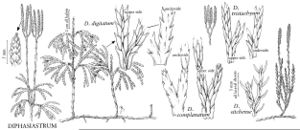Diphasiastrum sitchense
Preslia 47: 108. 1975.
Horizontal stems on substrate surface or shallowly buried, 1–2.7 mm wide; leaves appressed, broadly lanceolate, 1.8–3.2 × 0.5–1 mm, apex blunt. Upright shoots clustered and branching mostly at base, 5.5–17.5 cm; leaves appressed, broadly lanceolate, 1.8–3.2 × 0.5–1 mm, apex acuminate. Branchlets dark green, somewhat shiny, round in cross section, 1.7–2.5 mm wide, annual bud constrictions inconspicuous. Leaves on branchlets monomorphic, 5-ranked, not overlapping, appressed to spreading-ascending, incurved, free portion of blades 3.4–5.6 × 0.4–0.9 mm, widest at middle, apex sharply pointed. Peduncles absent or rarely 1 cm. Stalks absent. Strobili solitary on upright shoots, 4.5–38 × 3–5 mm, gradually narrowing to rounded tip. Sporophylls deltate, 1.8–3.6 × 1.7–2.8 mm; apex rounded. 2n = 46.
Habitat: Alpine meadows, open rocky barrens, conifer woods
Elevation: 200–2000 m
Distribution

Greenland, St. Pierre and Miquelon, Alta., B.C., Man., N.B., Nfld. and Labr., N.S., Ont., P.E.I., Que., Sask., Yukon, Alaska, Idaho, Maine, Mont., N.H., N.Y., Oreg., Vt., Wash., Asia in Kamchatka, Japan.
Discussion
The mature shoots in Diphasiastrum sitchense resemble the juvenile phases of the other species. The unique, round, 5-ranked leaves may represent an early developmental state.
The hybrid Diphasiastrum alpinum X sitchense is very rare. It is known from Greenland, British Columbia, Newfoundland, Montana, Oregon, and Washington. Specimens of D. sitchense from Greenland, Newfoundland, and Washington cited by J. H. Wilce (1965) are actually this hybrid.
Selected References
None.
